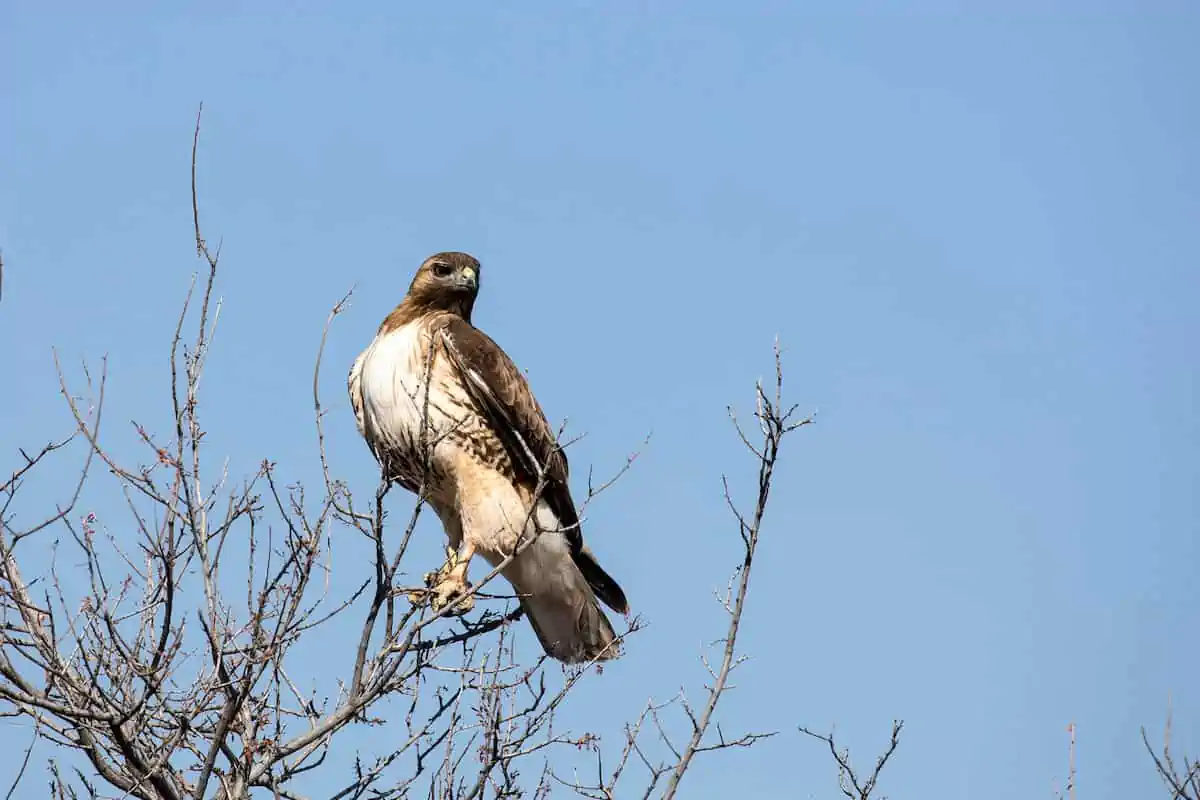
The family of hunting birds known as birds-of-prey includes hawks. Their keen hearing and sight, as well as their razor-sharp beak and talons, come together to make them outstanding predators. Hawks may be found in the United States, and there are about 16 different species. However, we’ll look at the eight different types of hawks found in Oregon, as well as a bonus hawk-like creature.
8 HAWKS IN OREGON
Cooper’s hawk, ferruginous hawk, northern goshawk, northern harrier, red-tailed hawk, rough-legged hawk, sharp-shinned hawk, and Swainson’s hawks are the eight types of hawks that may be found in Oregon.
Let’s take a look at each one.
1. COOPER’S HAWK

Scientific name: Accipiter cooperii
Length: 14.6 – 17.7 in
Weight: 7.8 – 24.0 oz
Wingspan: 24.4-35.4 in
Cooper’s hawks may be found across much of North America, from Oregon to Florida, where they stay all year. Adults have a red eye, a squared-off head with black hat, and a bluish-gray back with orange chest stripes. A yellow eye, brown back, and head, as well as white underparts with deep brown streaks, distinguish immature birds.
They seem to be happiest in the woods and woodlands, but they also appear to be comfortable in the suburbs. Little birds are their primary food source, and they quickly catch them in the tree canopy. The Cooper’s hawk has been known to attack birds at a feeder, particularly starlings, doves, and pigeons, and many people have seen them in their yard.
Cooper’s hawk skeletons show that many of them had broken bones in their chest, and crashing through trees and foliage on a high-speed pursuit after birds takes a toll.
2. FERRUGINOUS HAWK

Length: 22.1-27.2 in
Weight: 34.5-73.2 oz
Wingspan: 52.4-55.9 in
In the spring and summer, Ferruginous Hawks visit Oregon to breed, however they are only found in the eastern part. They fly above looking for tiny animals or hunting on the ground, preferring to remain in open areas such as fields and plains.
The biggest of all North American hawks is this one. Their backs, shoulders, underwings, and legs are rusty red in color and earned them the name “ferruginous.” They have gray streaked heads and white underparts.
Prairie dogs are often ambushed by Ferruginous Hawks in groups of 5-10. Before striking, they wait for prey to emerge from their holes. As the hawks begin hopping and flapping their wings, attracting more hawks and birds of prey in the process, this creates quite a spectacle.
3. NORTHERN GOSHAWK
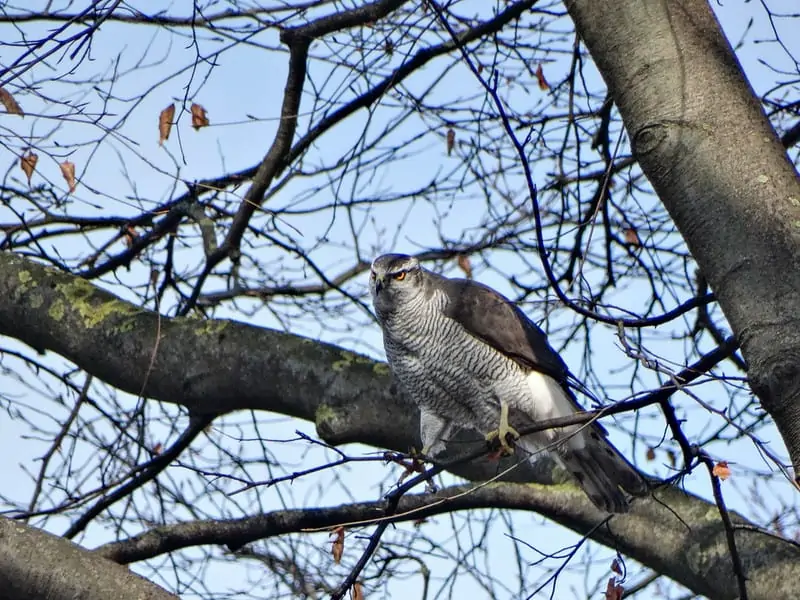
Scientific name: Accipiter gentilis
Length: 20.9-25.2 in
Weight: 22.3-48.1 oz
Wingspan: 40.5-46.1 in
The back of a goshawk is gray, and the chest is barred all the way down to the belly with a thick stripe over each eye. The sharp-shinned and cooper’s hawk are considered to be bigger and fiercer relatives of these birds. Goshawks, on the other hand, are very secretive and prefer to stay in the woods rather than go near human inhabited regions.
Many sections of Oregon are home to Northern Goshawks all year, however they are more frequent during the winter in others. Yet, because they prefer to dwell in vast portions of mature forest and avoid inhabited regions, it will be difficult finding one. They’ve been known to assault humans who approach their nests too closely. During the breeding season, be cautious when looking for these raptors.
Little hawks, birds, mammals, reptiles, and even insects and carrion are all part of the northern goshawk’s varied diet. Because of their covert nature, they are considered uncommon, and it is difficult to determine their number.
4. NORTHERN HARRIER

Scientific name: Circus hudsonius
Length: 18.1-19.7 in
Weight: 10.6-26.5 oz
Wingspan: 40.2-46.5 in
The face of the northern harrier is almost owl-like. This disc-shaped face, like that of an owl, guides sound into the ears of these creatures, allowing them to detect prey by both sound and sight. Their long tail and white patch above the tail are two helpful identifying features. They hold their wings in a “V” shape when they fly, which is a distinctive style. These birds are described as majestic by many people.
Throughout the year, this hawk can be found in eastern Oregon, as well as along the coast during the winter. Over marshes, fields, and other broad open spaces, you’re likely to see them.
This hawk creates a platform in thick vegetation, such as reeds, willows, sedges, and cattails, unlike other hawks that nest in trees. Males may have two (and sometimes more) partners at the same time, and both the female and her children will be fed by them.
5. RED TAILED HAWK
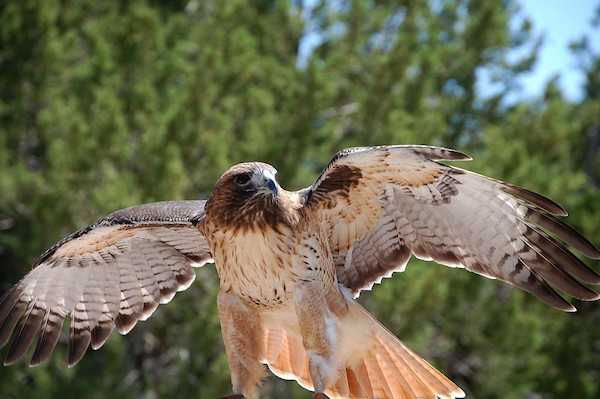
Scientific name: Buteo jamaicensis
Length: 17.7 – 25.6 in
Weight: 24.3oz – 51.5 oz
Wingspan: 44.9-52.4 in
The most common hawk in North America, red-tailed hawks may be found in practically every state, including Oregon, and live year-round.
Red-tailed hawks are most active in the day or early mornings, and they may be seen soaring along the road, using their exceptional vision to seek prey. Mice, rats, rabbits, and squirrels make up the majority of their diet. Birds and snakes are also possible food sources.
The tail of an adult is brick-red, making it simple to recognize. However, their tail is brown and white striped while still juveniles. The underside of these hawks is usually pale, while the top is dark brown. Their breast is streaked with brown, and their belly section is streaked with darker brown streaks, making them another easy distinguishing characteristic. There are numerous color variations across the country since these hawks are so ubiquitous.
The red-tailed hawk’s scream has become a symbol for all raptors and may be heard for several kilometers. Their scream is virtually always used as the sound for any hawk or eagle presented on screen in movies and television.
6. ROUGH-LEGGED HAWK
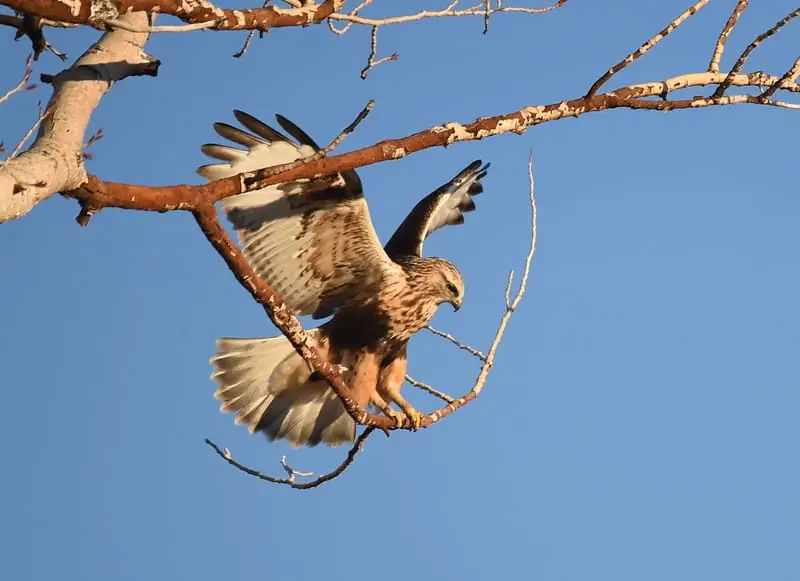
Scientific name: Buteo lagopus
Length: 18.5-20.5 in
Weight: 25.2-49.4 oz
Wingspan: 52.0-54.3 in
During the autumn and winter, rough-legged hawks can be seen across Oregon, although they are scarce along the coast. They trek all the way to the northern Arctic when it comes time to move to their breeding grounds! They’ll breed on towering cliffs and rocky outcroppings there.
They perch on poles and fence posts in the winter, when they can be found in wide-open areas. Mice, voles, and shrews are among the animals they hunt. To get a hover-in-place standpoint from which to observe the ground beneath them for their dinner, rough-legged hawks are known to turn into the wind and flap their wings.
The feathers on the legs of rough-legged hawks earned them the name. Feathers that extend all the way down a bird’s legs are rare in the United States. The majority are covered in large brown and white flecks, with a large black belly patch on some. As the wrist moves against a light backdrop, you’ll notice a black patch in the sky. A dark-morph looks like it’s two-toned from below, and it appears nearly black.
7. SHARP-SHINNED HAWK
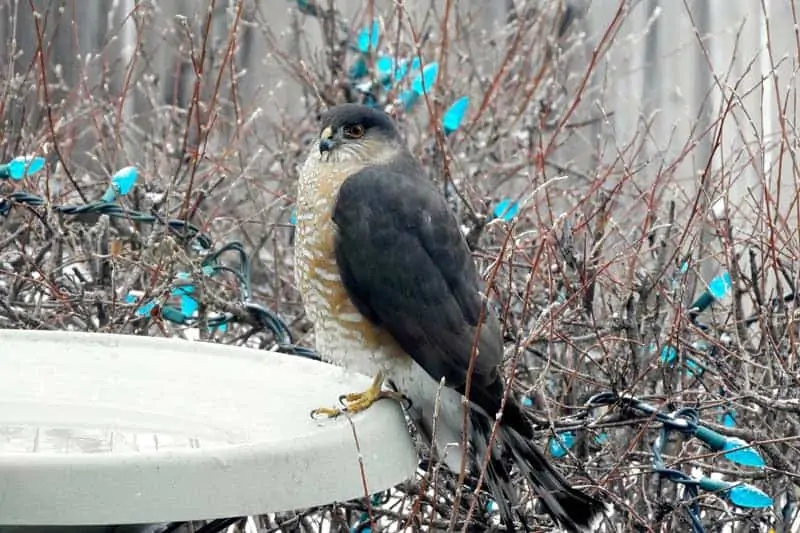
Scientific name: Accipiter striatus
Length: 9.4-13.4 in
Weight: 3.1-7.7 oz
Wingspan: 16.9-22.1 in
The smallest hawk in the United States is a sharp-shinned hawk. They are more likely to be seen during the winter along the shore and in areas of central Oregon, but they may be found throughout the year in other areas of the state. Little birds and rodents are prey for these hawks, which pursue them through the forest.
They hide in woods with thick canopy during the nesting season and are difficult to locate. They do visit around to hunt birds at feeders from time to time. While fall migration is the optimum time to observe them. They head south towards the US, passing via Canada. They are frequently seen at hawk watch sites from their summer habitat in Canada.
The backs of Sharp-shinned Hawks are blue-gray, with their cream-colored chests and black tail having reddish-orange stripes. With a more rounded head and squared-off tail, they resemble cooper’s hawks quite closely.
8. SWAINSONS HAWK

Scientific name: Buteo swainsoni
Length: 18.9-22.1 in
Weight: 24.4-48.2 oz
Wingspan: 45-55 in
Throughout the breeding season, Swainson’s Hawks may be found across Oregon, though they are less prevalent near the shore. During the summer, you’re likely to see them across broad swaths of open land. Telephone poles, wires, and secluded trees will all be used by them.
Kettles, which are as big as tens of thousands of hawks, are used to migrate Hawks. You should check out these raptors during their migration if you’ve ever seen a Broad-winged hawk!
As their habitat has altered throughout time, Swainson’s Hawks have adapted well to agricultural settings. In crops and fields, you may see them foraging for prey.
The chin is white, and the belly is streaked with rust. They have a gray head with a white bib. The brown chest and wings that seem to be unusually long with black edges when observed from below.
BONUS BIRD – THE OSPREY

Scientific name: Pandion haliaetus
Length: 21.3-22.8 in
Weight: 49.4-70.5 oz
Wingspan: 59.1-70.9 in
These birds do resemble hawks, and they are closely connected genetically, yet ospreys are classified independently due to their distinct genetic differences. Since ospreys eat almost solely fish, you will only notice this raptor if you are near water. They have a forward and backward gripping toe on their outer toes. Their grip on the slippery fish they capture is greatly improved as a result of this adaptation.
Throughout the summer, Ospreys may be found in a variety of places around Oregon. During spring and autumn migration, other sections of the state might see them. Find them near lakes, rivers, reservoirs, and marshes if you’re near any shallow fish-laden waters.
They’re easy to distinguish from hawks because of their coloring. They have a hooked beak, a white head with a big dark brown stripe across each eye. They have a pure white underbelly and back and wings that are dark brown from above. The undersides of their wings have a dark brown patch at the wrist while flying, which looks speckled.